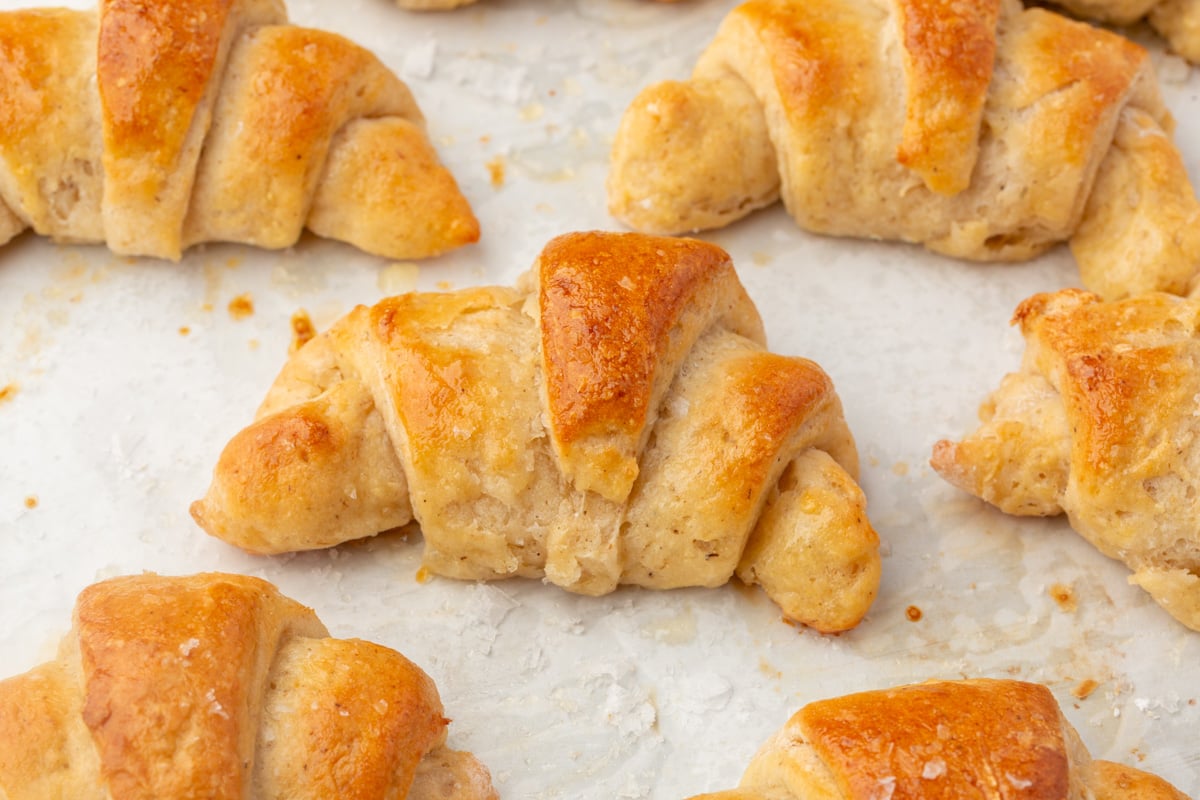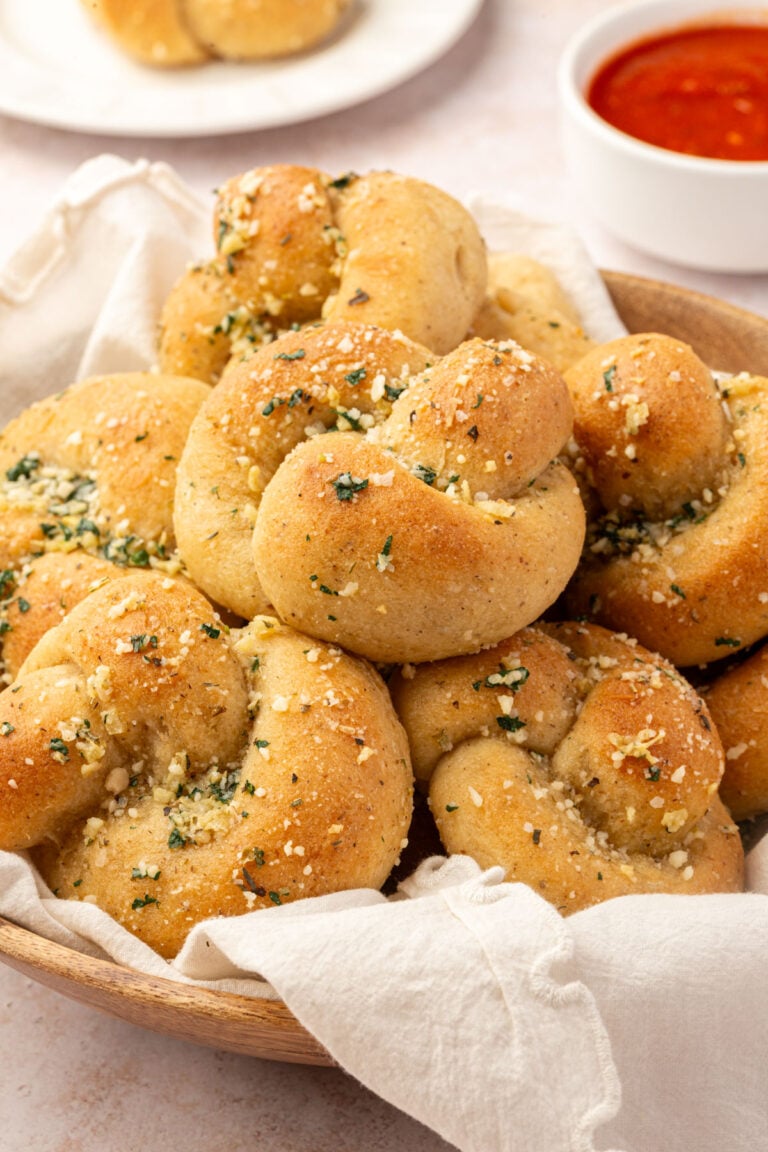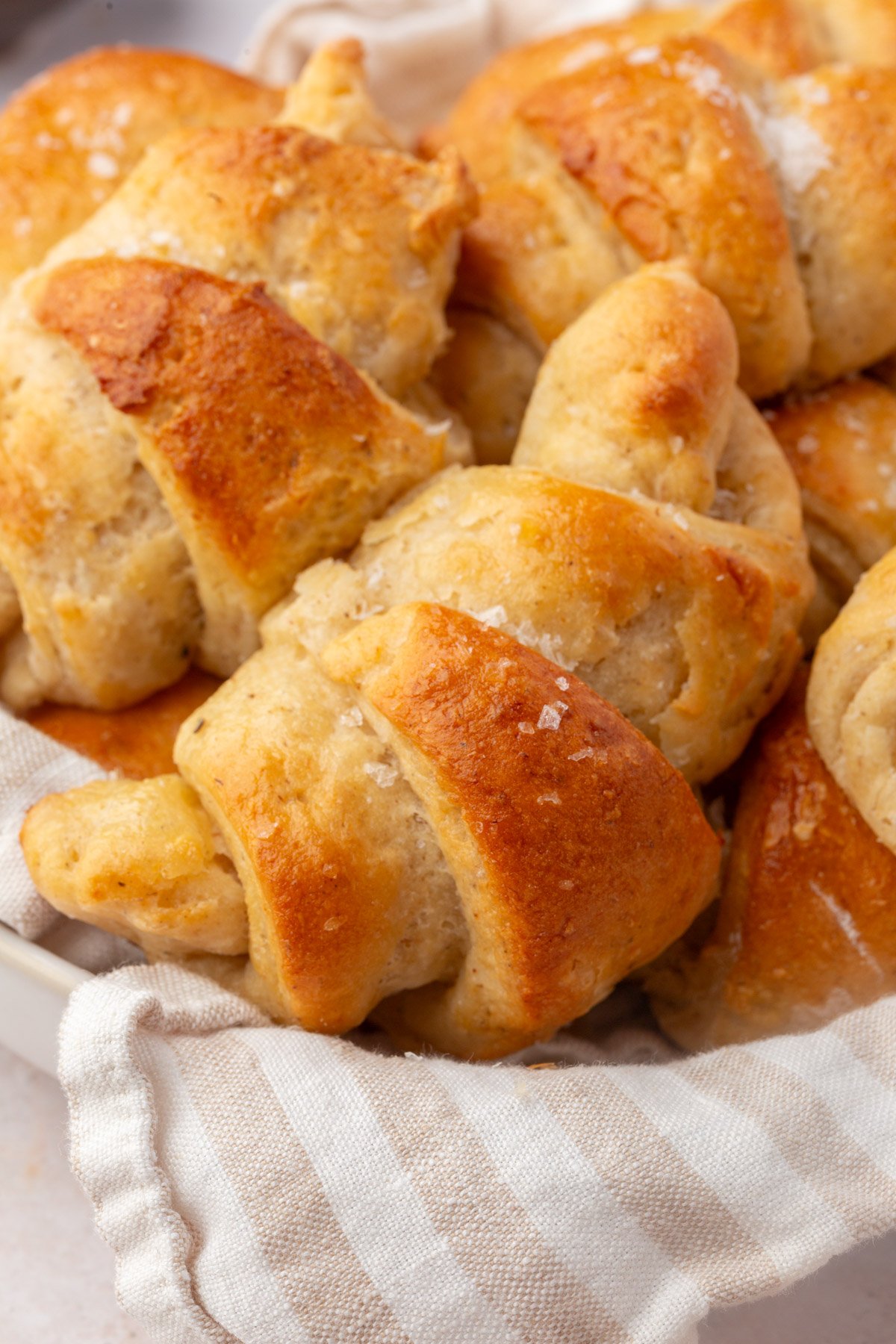
There’s something special about pulling apart a warm, flaky crescent roll: the way the buttery layers separate, the golden crust that shatters just slightly when you bite in. These gluten-free crescent rolls deliver exactly that, with tender, flaky layers that prove you don’t have to miss out on one of the best parts of the bread basket.
This recipe builds on my enriched gluten-free dough base (the same one I use for dinner rolls and cinnamon rolls) but with a simple lamination technique that creates those beautiful, pull-apart layers. A combination of melted butter in the dough and frozen grated butter folded in gives you the flakiness you’re craving without any gritty texture. Whether you’re serving these at Thanksgiving or alongside your favorite soup, they’re the buttery, golden crescents you’ve been missing.
Why You’ll Love this Recipe
Searching for more gluten-free bread recipes? gluten-free dinner rolls / gluten-free focaccia / gluten-free garlic knots
Ingredients

TIP
For the best texture, cut vegetables into larger chunks—carrots, celery, and potatoes can break down too much and become mushy if cut too small.
Searching for more gluten-free dinner recipes? spinach feta egg muffins / gluten-free breakfast casserole / gluten-free mini quiches
Ingredient Notes
- Brown Rice Flour – This is the base of our custom flour blend. I buy finely ground brown rice flour to make sure that my crescent rolls aren’t too gritty.
- Tapioca Starch & Potato Starch – This starch duo is essential for texture. Tapioca brings stretch and chew, while potato starch keeps things light and helps achieve that golden-brown finish.
- Xanthan Gum – Acts as the glue that holds everything together. Without gluten, we need xanthan gum to give the dough enough structure to roll out and fold without falling apart.
- Whole Psyllium Husk – When you mix this with warm water, it creates a gel that adds strength and elasticity to the dough. This is what lets you roll and shape the crescents without cracks or dry spots. I prefer to use whole psyllium husk instead of psyllium husk powder because I find the powder has a tendency to clump together and not get a smooth gel.
- Instant Yeast – No waiting around to proof yeast here. Instant yeast mixes right into your dry ingredients and gets to work as soon as the dough comes together.
- Milk, Butter, and Eggs – The trio that makes this dough rich and tender. Together, they create that golden color and soft interior you want in a really good crescent roll.
- Sugar – Just enough to feed the yeast and round out the flavors. You won’t taste sweetness in the finished crescents.
Testing Process
Getting these crescent rolls right took more trial and error than I’d like to admit. I knew I wanted flaky layers, but every approach had a tradeoff.
My first test was simple: take my gluten-free dinner rolls dough and shape it into crescents. They were delicious, soft, and buttery, but there weren’t any real layers. I wanted to see if I could push this dough further.
Next, I tried spreading a thin layer of melted butter onto the rolled-out dough before slicing it into wedges. It helped a little, giving a hint of flakiness, but I knew we could do better.
Then I tried working cold butter into the dough, just like my gluten-free cheddar drop biscuits. The layers were gorgeous and the flakiness was exactly what I wanted, but the texture was gritty. Without being able to knead the dough long enough (the butter would melt and incorporate too much), the brown rice flour never fully hydrated. Not great.
What finally worked was a combination approach: melted butter goes into the dough itself, which keeps it soft and workable so I can knead to my heart’s content. This ensures the brown rice flour is fully hydrated and there’s no gritty mouthfeel. Then, I grate frozen butter over the rolled dough and do two letter folds before rolling it into a cylinder and then into the final circle for cutting. This creates laminated layers without sacrificing texture.
The result is a smooth, tender dough with visible flaky layers that actually pull apart.
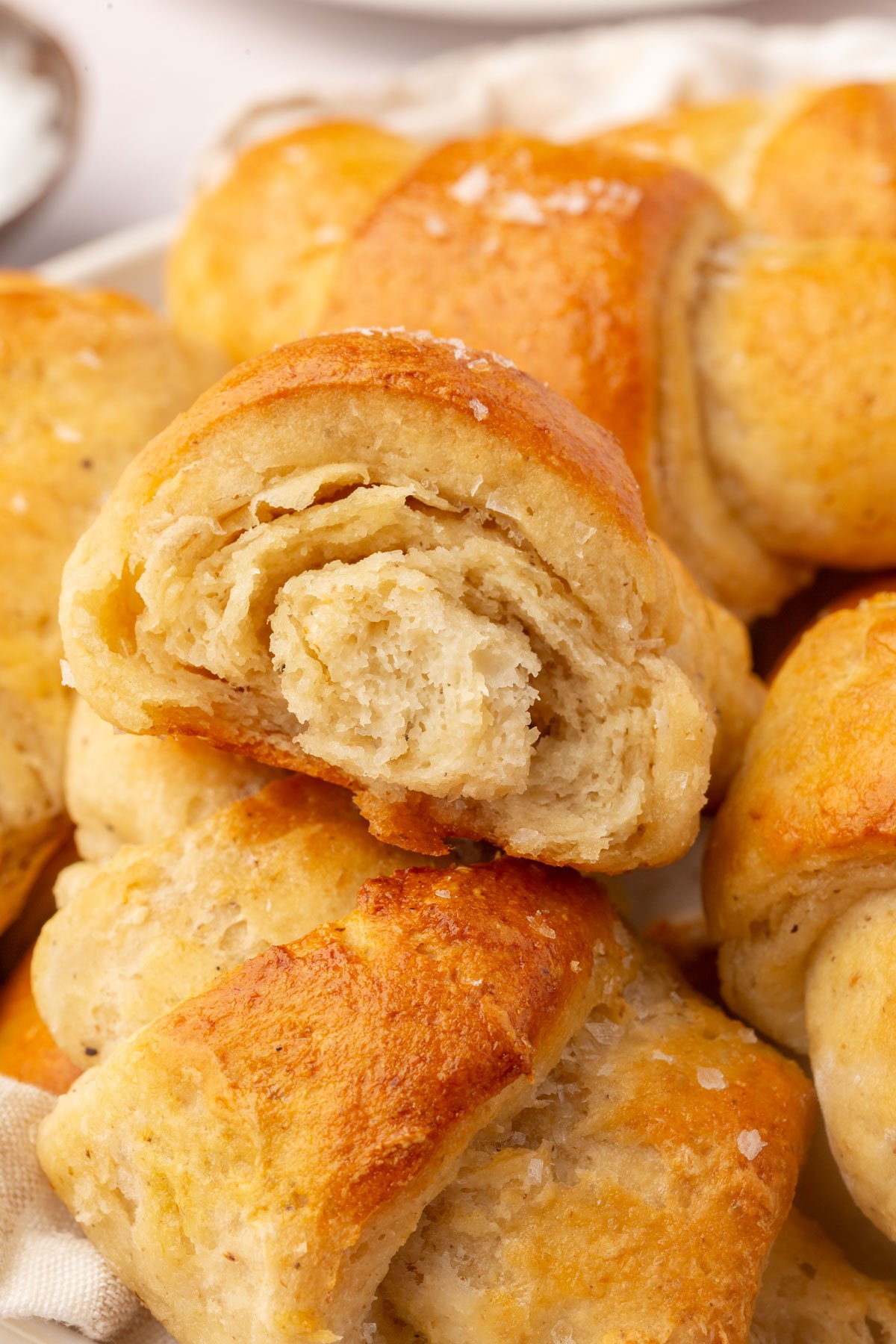
About the Laminating Technique
Don’t let “laminating” scare you off. This isn’t croissant-level fussiness. You’re just doing two simple letter folds to create layers, and the whole process takes about five minutes.
Here’s what you’re doing: roll the dough into a rectangle, grate frozen butter over the entire surface, then fold it like a letter (one third folds over the middle, then the other third folds on top). Give it a quarter turn, roll it out again, and do one more letter fold. That’s it.
Then you roll the dough into a cylinder, which helps distribute those butter layers evenly, before rolling it into your final circle for cutting the crescents. Even if your folds aren’t perfect or some butter peeks out, you’ll still get flaky layers. The frozen butter is forgiving and the dough is easy to work with.


Recipe FAQs
I don’t recommend it. Most gluten-free flour blends aren’t formulated for yeast doughs and they absorb liquid differently, which can make the rolls dense or dry. This specific blend was tested to get that soft, flaky texture.
Yes! Psyllium husk gives the dough strength and flexibility so you can roll it out and fold it for those flaky layers. Without it, the dough won’t hold together well enough to laminate. I recommend whole psyllium husk, not the powder.
The melted butter in the dough keeps it smooth and workable so you can knead it properly (which prevents grittiness). The frozen grated butter creates the flaky layers. You need both for the best texture.
Expert Tips
Storage instructions
These gluten-free crescent rolls are best enjoyed the day they are baked, when the layers are at their flakiest and most tender.
Storing Baked Rolls:
If you have leftovers, store them in an airtight container at room temperature for up to 2 days. I’d suggest reheating them to get them soft and warm again as they get a little denser as they cool.
Reheating:
To refresh the texture and bring back some of that flakiness, wrap rolls in foil and warm in a 300°F oven for 5 to 7 minutes until soft and heated through. You can also microwave a single roll for about 15 seconds, covered with a damp paper towel to keep it moist, though the oven method is better for maintaining the flaky texture.
Freezing:
Allow baked rolls to cool completely, then wrap tightly in foil and place in a freezer-safe bag for up to 2 months. To reheat, thaw overnight in the refrigerator and warm in a 325°F oven until soft and heated through.
Make Ahead Option
You can prepare the dough a day in advance. After shaping the crescents, cover the baking sheet tightly with plastic wrap and refrigerate overnight. The next day, let them sit at room temperature for about an hour to finish rising before baking. This is perfect for holidays or hosting when you want fresh-baked rolls without the rush.
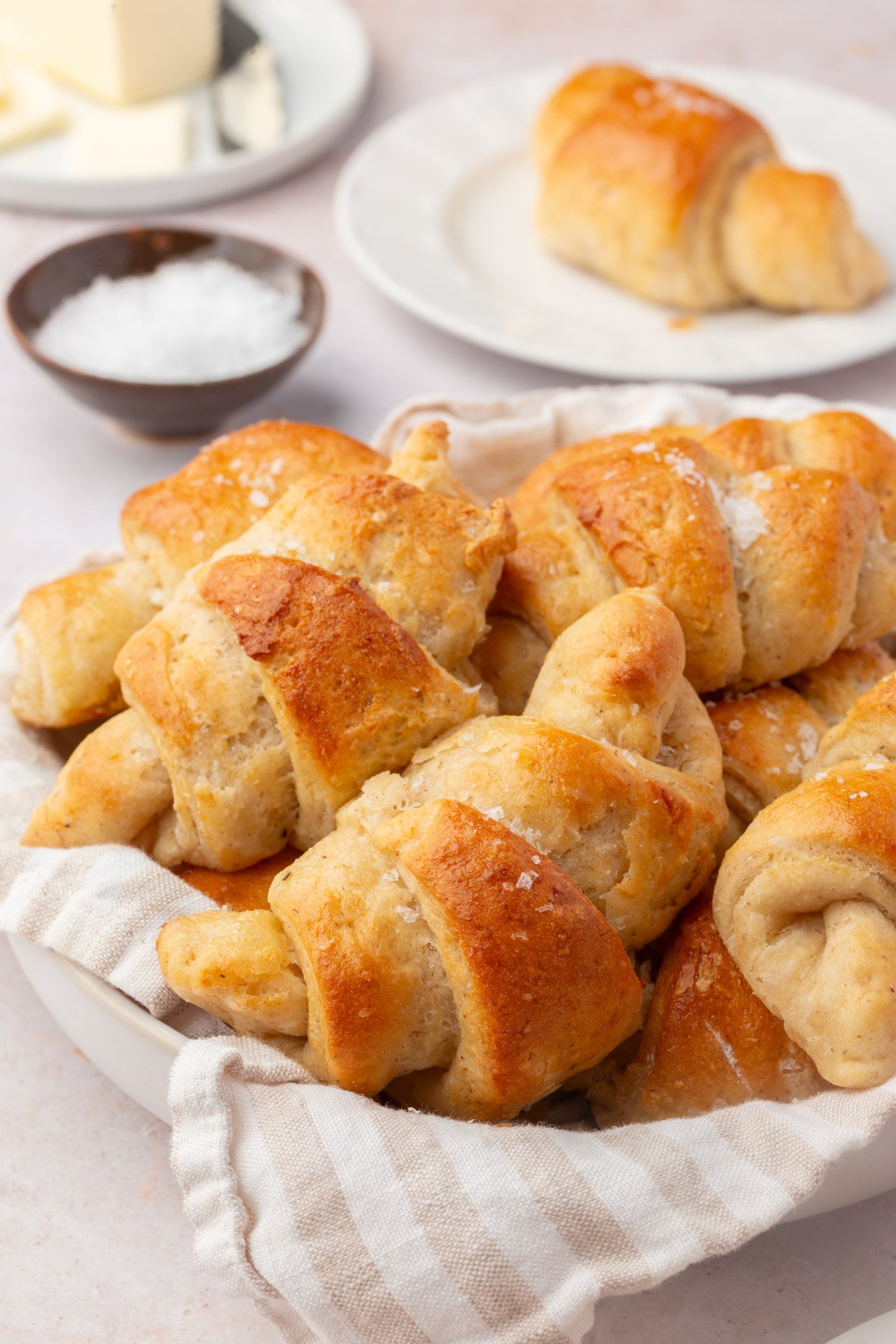
Serving suggestions
These gluten-free crescent rolls are incredibly versatile and pair beautifully with just about any meal. Serve them warm alongside my gluten-free broccoli cheddar soup, gluten-free chicken noodle soup, or gluten-free beef stew for a cozy weeknight dinner.
They’re also perfect for holiday tables. Serve them at Thanksgiving with gluten-free gravy and red wine cranberry sauce, or alongside your Christmas ham or roast. The buttery, flaky layers make them feel special enough for any celebration.
For extra flavor, brush the warm rolls with garlic butter (just mix melted butter with minced garlic and a pinch of salt) or herb butter (add fresh rosemary, thyme, or parsley). You can also use them for sliders or mini sandwiches, split them for breakfast sandwiches, or serve them with honey butter for a slightly sweet treat.
If you’re hosting brunch, these crescents are excellent alongside spinach feta egg muffins, gluten-free breakfast casserole, or a simple fruit salad.
More gluten-free breads to try
Did you make this recipe?
I’d love to know! Please rate it and leave a comment below. You can also share your pictures and tag @adashofmegnut on Instagram.

Gluten-Free Crescent Rolls
Ingredients
Dry Ingredients
- 160 g brown rice flour – about 1 cup
- 115 g tapioca starch – about 1 cup
- 75 g potato starch – about ½ cup
- 50 g ¼ cup granulated sugar
- 8 g 1½ teaspoons kosher salt
- 7 g instant yeast – about 2¼ teaspoons - 1 packet
- 6 g xanthan gum – about 2 teaspoons
- 8 g baking powder – about 2 teaspoons
Psyllium Mixture
- 16 g whole psyllium husk – about 2 tablespoons
- 160 g warm water – about ⅔ cup - about 100°F
Wet Ingredients
- 160 g warm whole milk – about ⅔ cup - 100–110°F
- 1 large egg – about 50 g
- 42 g 3 tablespoons unsalted butter – melted and slightly cooled
- 5 g 1 teaspoon apple cider vinegar
For Laminating
- 42 g 3 tablespoons unsalted butter – frozen and grated on the largest hole of your cheese grater
For Brushing
- 1 egg – beaten - for egg wash
- 14 g 1 tablespoon melted butter – for brushing after baking
- ½ teaspoon flaky sea salt – for finishing - such as Maldon salt
**Use the toggle button above to turn the instruction photos on and off!
Instructions
- Mix the dry ingredients: In the bowl of a stand mixer, combine 160g brown rice flour, 115g tapioca starch, 75g potato starch, 50g sugar, 8g salt, 7g instant yeast, 6g xanthan gum, and 8g baking powder. Whisk to combine evenly.
- Make the psyllium gel: In a small bowl, whisk together 16g whole psyllium husk and 160g warm water until thickened into a gel. Set aside for about one minute to hydrate fully.
- Combine the wet ingredients: In a medium bowl, whisk together 160g warm milk, 1 egg, 42g melted butter, and 5g apple cider vinegar. Add in the psyllium gel and whisk until smooth and uniform.
- Make the dough: Pour the wet ingredients into the dry ingredients. Using the dough hook attachment, mix on medium speed for about 5 minutes, scraping the sides and bottom of the bowl as needed. The dough should be soft, thick, and slightly sticky.
- First roll: Lightly dust your work surface with tapioca starch. Turn out the dough and pat into a rough rectangle. Roll into a 10×14-inch rectangle about ¼-inch thick.
- Add the frozen butter: Using a box grater, grate 42g (3 tablespoons) frozen butter evenly over the entire surface of the dough, leaving no bare spots.
- First letter fold: Fold the right third of the dough over the center, then fold the left third over that. Give the dough a quarter turn so the whole thing is now horizontal in front of you.
- Second roll and fold: Roll the dough back out into a 10×14-inch rectangle. Fold the right third over the center, then fold the left third over that. The dough should feel cool but pliable.
- Roll into cylinder: With your hands, roll up the folded dough from the short side into a cylinder (it will look like a massive cinnamon roll) to distribute the butter layers evenly, then roll out with the rolling pin into a 14-inch circle about ⅛-inch thick.
- Cut the crescents: Using a pizza cutter or sharp knife, cut the circle into 12 equal wedges (like cutting a pizza).
- Shape the rolls: Starting from the wide end of each wedge, roll toward the point. Place seam-side down on a parchment-lined baking sheet, leaving about 2 inches between each roll. Curve the ends slightly inward to create the classic crescent shape.
- Proof the rolls: Cover loosely and let rise in a warm spot (75–80°F) for about 45–60 minutes, or until puffy and nearly doubled in size.
- Bake: Preheat the oven to 375°F (190°C). Brush the tops with 1 beaten egg for shine. Bake for 18-22 minutes, or until golden brown and the centers reach 200°F.
- Finish: While still warm, brush the tops with 14g (1 tablespoon) melted butter and sprinkle lightly with flaky sea salt. Let cool for a few minutes before serving.
Notes
- Flour Blend: Store-bought gluten-free blends don’t perform well in yeast recipes. This custom blend gives the best soft, flaky texture.
- Make-Ahead: Shape the crescents and place on the baking sheet. Cover tightly and refrigerate overnight. The next day, let sit at room temperature for about 1 hour to finish rising before baking.
- Best Served: Fresh on the day they’re baked. Reheat leftovers gently in the oven, wrapped in foil, at 300°F for 5–7 minutes.
Nutrition
